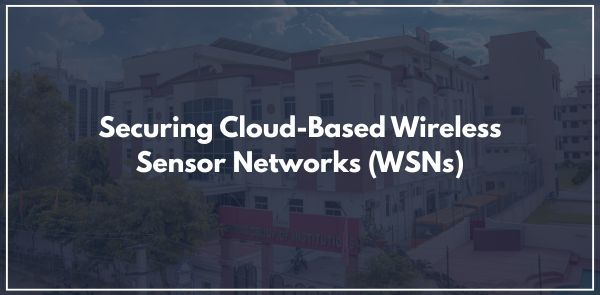
Wireless Sensor Networks (WSNs), integrated with cloud computing, offer powerful solutions for diverse applications like environmental monitoring, smart agriculture, and industrial automation. This integration leverages the cloud's vast storage and processing capabilities to handle the massive data generated by WSNs. However, this synergy also introduces significant security vulnerabilities that must be addressed to ensure the reliability and integrity of these systems. At, Poddar Group of Institutions- recognized as top BCA and MCA college in Jaipur- with cutting –edge resources like Apple Lab – we explore how technology and education intersect to address these pressing concerns.
The distributed nature of WSNs, coupled with the cloud's remote accessibility, creates a complex security landscape arising security challenges as follows:
1. Data Confidentiality and Integrity: Sensitive data collected by sensors needs protection from unauthorized access and manipulation during transmission and storage in the cloud.
2. Authentication and Authorization: Securely authenticating sensor nodes and cloud users is crucial to prevent unauthorized access and control of the network.
3.Key Management: Efficiently managing and distributing encryption keys across a large number of sensor nodes and cloud servers is a complex task. Approaches like hierarchical key management and pre-distribution are often deployed in scalable WSNs.
4. Node Capture and Compromise: Sensor nodes, often deployed in unattended environments, are vulnerable to physical capture and compromise, potentially leading to data breaches or network disruption.
5. Denial of Service (DoS) Attacks: Cloud resources and sensor communication channels can be targeted by DoS attacks, disrupting data collection and processing.
6. Cloud Security Risks: Cloud-specific vulnerabilities, such as data breaches, insider threats, and virtualization attacks can also impact WSN security.
7. Heterogeneous Security Requirements: Different WSN applications have varying security needs, requiring flexible and adaptable security solutions.
8. Limited Resources of Sensor Nodes: Sensor nodes typically have limited processing power, memory, and energy, making it challenging to implement complex security protocols.
Addressing these security challenges requires a multi-layered approach that considers the unique characteristics of both WSNs and cloud environments.
1. End-to-End Encryption: Encrypting sensor data from the point of collection to the cloud storage ensures data confidentiality and integrity. Lightweight but strong encryption algorithms are preferred for sensor nodes.
2. Robust Authentication and Authorization: Implementing strong authentication mechanisms, such as digital signatures and public-key cryptography, is essential for secure node and user authentication. Role-based access control (RBAC) in the cloud can manage user permissions.
3. Secure Key Management: Employing efficient key distribution and management schemes, such as key pre-distribution, key agreement protocols, and hierarchical key management is crucial.
4.Intrusion Detection Systems (IDS): Deploying IDS at both the sensor node and cloud levels can detect and respond to malicious activities. Cloud-based IDS can analyze network traffic and sensor data for anomalies.
5.Secure Data Aggregation: Implementing secure data aggregation techniques can reduce the amount of data transmitted to the cloud, minimizing the risk of interception.
6. Physical Security Measures: Protecting sensor nodes from physical capture through tamper-resistant hardware and secure deployment strategies is essential.
7.Cloud Security Best Practices: Adhering to cloud security best practices, such as data encryption, access control, and regular security audits, is vital.
8.Lightweight Security Protocols: Developing and implementing lightweight security protocols that are optimized for resource-constrained sensor nodes is critical.
9.Federated Learning: Leveraging federated learning allows for machine learning directly on the sensor data, without needing to send all sensitive data to the cloud. This increases privacy.
10. Blockchain Integration: Using blockchain integration to secure the data transfer and storage, and to secure the authentication and authorization processes.
Successful implementation of security solutions requires careful planning and consideration of several factors:
1.Scalability: Security solutions must be scalable to accommodate large-scale WSN deployments.
2.Energy Efficiency: Security protocols must be energy-efficient to prolong the lifetime of sensor nodes.
3.Computational Overhead: Security algorithms should minimize computational overhead on sensor nodes.
3.Cost-Effectiveness: Security solutions should be cost-effective and feasible for deployment in resource- constrained environments.
4.Interoperability: Security solutions must be interoperable with existing WSN and cloud infrastructure.
As cloud-based WSNs continue to evolve, research efforts should focus on developing context-aware security solutions that adapt to changing network conditions.
1. Exploring the use of artificial intelligence and machine learning for proactive threat detection and response.
2.Investigating the application of quantum-resistant cryptography for future-proof security.
3. Standardizing security protocols for cloud-based WSNs to ensure interoperability and compatibility.
Securing cloud-based WSNs is crucial for realizing their full potential. By implementing robust security measures and adopting best practices, we can ensure the reliability, integrity, and confidentiality of these critical systems.